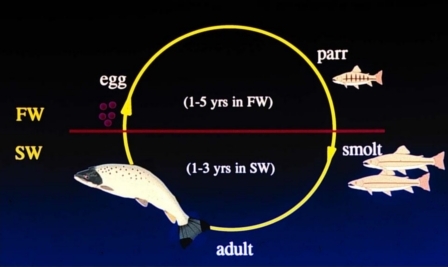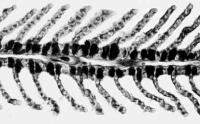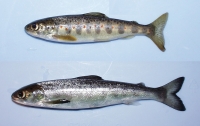The Biology of Salmon Smolts
Stephen D. McCormick
A hallmark of salmon life history is the movement from early rearing areas in streams to the ocean. The downstream migratory stage of salmon is known as the smolt stage. Smolts are usually about 5-7 inches (13-18 cm), and two to five years old, this age depending largely on the conditions for growth in their natal streams. Coincident with their downstream migration in spring, the vertical bars on their sides known as parr marks are lost, and smolts become a bright silver color with dark fin margins. Along with these external changes, smolts undergo a variety of behavioral and physiological changes that equip them for survival during downstream migration and entry into the ocean. One of the most important changes is the capacity to secrete salts in order to successfully make the transition from fresh water to seawater.
All bony fish (teleosts) maintain the salt content of their blood at about one-third the concentration of seawater (the same is true for most other vertebrates including humans). Thus, when fish are in fresh water they must take up salts from their environment and rid themselves of excess water. They do this by actively taking up sodium, chloride and other ions across the gills. Excess water is taken care of by the kidney which creates a highly dilute (low salt) urine. Conversely, when in seawater fish must get rid of excess salts and conserve water. Fish drink more in seawater than in fresh water in order to obtain water. As in fresh water the gills are the site of sodium and chloride regulation, but in seawater active secretion takes place. The kidney makes an “isoosmotic” urine (same salt content as the blood), but excretes the excess divalent ions such as calcium and sulfate.
 Anadromous life cycle of Atlantic salmon
Anadromous life cycle of Atlantic salmonMost fish do not have the capacity to move between fresh water and seawater because they lack the capacity to reverse the ion pumping mechanisms described above. Salmon are among the few fish that do have this capacity, known as “euryhalinity”. In the spring, smolts develop a high degree of salt secretory ability before and during their downstream migration. This allows them to completely regulate the salt content of their blood as they rapidly move through estuaries and into the ocean. The physiological changes that occur in fresh water are cued by a combination of increases in daylength and temperature that both increase in spring. These cues signal endocrine glands to secrete increased levels of growth hormone, cortisol and thyroid hormones. These hormones interact to bring about specific changes in the gills, gut and kidney that result in increased seawater tolerance. Some of the most well-studied changes are increases in the size and number of gill “chloride cells” (also known as “mitochondria-rich cells”) that secrete excess sodium and chloride, and increased levels of gill Na,K-ATPase, the energy-demanding sodium pump.
These and other physiological changes allow salmon to make a rapid transition from the river to ocean environment with a high degree of success. However, the basic biology of smolts also appears to make them vulnerable to a variety of environmental perturbations. Many aspects of smolting, including salinity tolerance, are naturally reversible and last for a limited period of time. Delays in migration (such as those caused by dams) and increased temperature can have negative impacts on smolts by disrupting the normal timing of seawater entry. Recent research indicates that smolt development can be severely compromised by exposure to acid, aluminum, and some organic pollutants. As with other aspects of the salmon life history the smolt stage may be an environmental sentinal, being highly sensitive to environmental changes, especially those caused by human activity.


